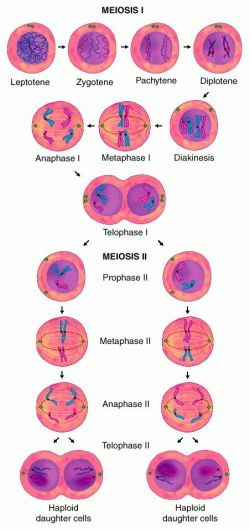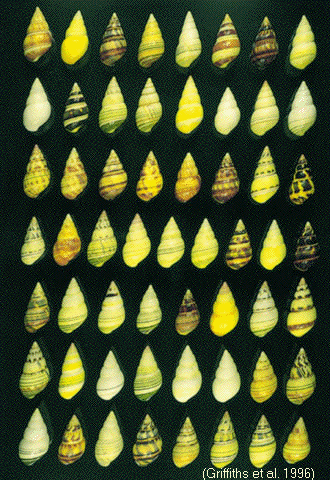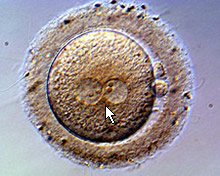Chapter 13 Vocab
Heredity- The transmission of traits from one generation to the next.


Variation- Differences between members of the same species.
Synapsis- The pairing and physical connection of replicated homologous chromosomes during prophase I of meiosis.

Tetrad- (1) Four homologous chromatids in a bundle in the first meiotic prophase and metaphase. The meiotic configuration of four chromatids first seen in pachytene. There is one tetrad per pair (bivalent) of homologous chromosomes. (2) The four haploid product cells from a single meiosis.
Gene- A discrete unit of hereditary information consisting of a specific nucleotide sequence in DNA (or RNA, in some viruses).
Meiosis- A modified type of cell division in sexually reproducing organisms consisting of two rounds of cell division but only one round of DNA replication. It results in cells with half the number of chromosome sets as the original cell.
Chiasma- The X-shaped, microscopically visible region where homologous nonsister chromatids have exchanged genetic material through crossing over during meiosis, the two homologs remaining associated due to sister chromatid cohesion.
Crossing over- The reciprocal exchange of genetic material between nonsister chromatids during prophase I of meiosis.
Homologous structure- A pair of chromosomes of the same length, centromere position, and staining pattern that possess genes for the same characters at corresponding loci. One homologous chromosome is inherited from the organism’s father, the other from the mother. Also called homologs, or a homologous pair.
Locus- A specific place along the length of a chromosome where a given gene is located.
Karyotype- A display of the chromosome pairs of a cell arranged by size and shape.

Clone- (1) A lineage of genetically identical individuals or cells. (2) In popular usage, a single individual organism that is genetically identical to another individual. (3) As a verb, to make one or more genetic replicas of an individual or cell. See also gene cloning.
Syngamy- The fusion of two gametes in fertilization.
And the following words can be found in the last image, the key shows the colors for haploid and diploid structures, with blue as haploid and green as diploid.
Diploid cell- A cell containing two sets of chromosomes (2n), one set inherited from each parent.
Haploid cell- A cell containing only one set of chromosomes (n).
Spore- In the life cycle of a plant or alga undergoing alternation of generations, a haploid cell produced in the sporophyte by meiosis. A spore can divide by mitosis to develop into a multicellular haploid individual, the gametophyte, without fusing with another cell. (2) In fungi, a haploid cell, produced either sexually or asexually, that produces a mycelium after germination.
Sporophyte- In organisms (plants and some algae) that have alternation of generations, the multicellular diploid form that results from the union of gametes. The sporophyte produces haploid spores by meiosis that develop into gametophytes.
Gametophyte- In organisms (plants and some algae) that have alternation of generations, the multicellular haploid form that produces haploid gametes by mitosis. The haploid gametes unite and develop into sporophytes.

Roots:
-apsis-juncture
tetra- four
chiasm- marked crosswise
syn-together
fertil-fruitful
homo-like
haplo-single
sporo-a seed
And now the meiotic division of an animal cell...
Meiosis is divided into two parts, the first part is called Meiosis I: Separates Homologous Chromosomes
Prophase I:
- Chromosomes begin to condense, and homologs loosely pair along their lengths lined up gene by gene
- Crossing over is completed while homologs are in synapsis and held tightly together by proteins along their lenghts
- Synapsis ends in mid-prophase and the chromosomes in each pair move apart slightly
- Each homologous pair has one or more chiasmata, points where crossing over has occured and the homologs are still associated due to cohesion between sister chromatids
- Centrosome movement, spindle formation, and nuclear envelope breakdown occur
- In late propahse I, micortubules from one pole or another attach to the two kinetechores, protein structures at the centromeres of the two homologs
- The two homologous pairs then move toward then move towards the metaphase plate
- Pairs of homologous chromosomes are arranged at the metaphase plate with one chromosome in each pair facing each pole
- Both chromatids of one homolog are attached to kinetechore microtubules from one pole, the others are attached to the opposite pole
- Breakdown of proteins responsible for sister chromatid cohesion along chromatid arms allowds homologs to seperate
- The homologs move toward opposite poles, guided by the spindle apparatus
- Sister chromatid cohesion persists at the centromere causing chromatids to move as a unit toward the same pole
- At the beginning of telophase I each half of the cell has a complete haploid set of replicated chromosomes, each chromosome is composed of two sister chromatids. One or both chromatids include regions of nonsister chromatid DNA
- Cytokinesis usually occurs at the same time as telophase I, forming two haploid daughter cells
- In animal cells, a cleavage furrow forms, in plant cells, a cell plate forms
- No replication occurs between Meiosis I and II
Propahse II
- A spindle apparatus forms
- In late propahse II chromosomes move towards the metaphase plate
- The chromosomes are posistioned on the metaphase plate
- Because of crossing over in meiosis I the two sister chromatids of each chromosome are not genetically identical
- The kinetechores of sister chromatids are attached to microtubules extending from opposite poles
- Breakdown of proteins holding the sister chromatids together at the centromere allows the chromatids to seperate
- The chromatids move towards opposite poles
- Nuclei form, the chromosomes begin decondensing, and cytokineses occurs
- The meiotic division of one parent cell produces four daughter cells , each with a haploid set of unreplicated chromosomes
- Each of the four daughter cells is genetically distinct from the other daughter cells and from the parent cell

Questions:
1. Meiosis has______round(s) of DNA replication
- one
- two
- four
- six
- Prophase II
- Metaphase I
- Prophase I
- Metaphase II
4. Humans have what kinds of chromosomes?
Answers:
1. 1 2. 3 3. False 4. X, Y and autosomes








No comments:
Post a Comment